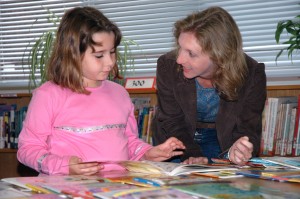Nine TLS staff members attended a JASPER training session at TLS Central on May 6.
JASPER stands for Joint Attention, Symbolic Play, Engagement and Regulation, which are also the four main objectives to the approach. It targets the foundation of social communication – join attention, imitation and play – and uses naturalistic strategies to increase the rate and complexity of social communication.
Lauren Elder, a psychologist from California, facilitated the JASPER training. She helped the staff members identify different levels of play in children on the autism spectrum, and apply behavioral principals to those levels to help them achieve their goals.
Tiffanie Ryan, a Board Certified Behavior Analyst at TLS, said the approach is inclusive of having parents and teachers as implementers.
“The thought process is that if we are able to work through and figure out the level of play a child on the spectrum is at, we can work to build their play skills. That will help their social development,” Tiffanie said.
JASPER is designed for preschool aged children through 11 years old who have little or no functional communication. The therapy sessions last around 20 minutes, and are incorporated into the overall treatment. Teachers can work with a child one-on-one within the classroom setting.
Tiffanie said the JASPER approach is fluid and flexible, as opposed to other therapies that are perceived as rigid and more structured. Therefore the implementation of it is more of an art than a science. There is very little language involved. If a child only utters one or two words, the teacher is uttering two or three words. It’s direct, simple, and helps the child expand his or her communication because they are being met at their level and encouraged to go one step above.
The TLS staff learned to identify the 10 levels of play, which ranged from beginning play through semantic fantasy play, and how to find developmentally appropriate toys for each level. They learned to work with the child where he or she is at, or one level above, and challenge them to move to the next level. Flexibility is key, and staff was trained on keeping the child engaged and interacting.
The training began with a lecture, role-playing with the trainer, and transitioned into working hands-on with four TLS students whose parents had given permission to participate.
Bynn Artim, Behavior Analyst at TLS, said the students responded well to the training.
“One of our students was an early learner, and by the end of the 20-minute play session he had independently received and directed another individual’s attention,” she said.
Laura Litavish, TLS’s Pre-K Intervention Specialist, said the student she worked with engaged in one activity for a longer period of time compared to what she has observed in the classroom. He seemed to enjoy having adults mimicking his movements, and even began to mimic hers.
The skills students learn through JASPER build a strong foundation for future skill acquisition, and can lead to a reduction in problem behaviors. When students can communicate their needs and wants, it reduces their need to engage in the problematic behaviors that they used in the past.
TLS plans to continue practicing the JASPER strategy, and gradually add the strategies they learned into the classroom setting beginning in the fall. Laura said the JASPER method should have a positive impact on the daily lives of her students.
“I hope the students in my class will learn basic play skills and communication skills that they will use in the classroom, at home, and in public,” she said. “The children will learn how to play appropriately with toys and be engaged in play for longer periods of time.”
For more information about the JASPER training and how it will be implemented in the classroom, contact TLS at 614-844-5433.

